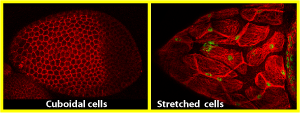Accueil du site > Thèmes de recherche > Epithelia. Group leader : Muriel Grammont > Presentation
Presentation
Team leader
- Grammont Muriel, - CR CNRS
Team Members
- Pascale Milani, - Researcher ANR
- Julien Chlasta, - PhD Student
- Jean-Luc Duteyrat, - Assistant Engineer CNRS
Project :
Epithelia form a vital part of all our tissues and organs. The adhesive properties of these cellular sheets and the ability of their component cells to change shape and/or to move are essential to generate a large number of tissues and organs. The general context of my research addresses the following question : what are the cellular and molecular mechanisms that link epithelial cell differentiation and the underlying morphogenetic processes ? Drosophila oogenesis provides an elegant context in which to study epithelial processes such as differentiation, change of form, displacement and migration, since they can be observed in the course of the development of a single follicle.

A follicle is the structure that contains a growing oocyte connected to 15 nurse cells. This group of 16 cells is surrounded by a monolayer of epithelial cells, called the follicular cells, that undergoes multiple morphogenetic processes during the growth and the maturation of the oocyte.
 The first aspect of our work concerns the role of the polar cells (red asterisk), which are crucial for ovarian follicle formation and follicular cell differentiation. Either extremity of each follicle contains two polar cells that control the differentiation of the neighbouring cells by secreting signals. We study the genes that regulate their formation, their numbers and their organizing activity.
The first aspect of our work concerns the role of the polar cells (red asterisk), which are crucial for ovarian follicle formation and follicular cell differentiation. Either extremity of each follicle contains two polar cells that control the differentiation of the neighbouring cells by secreting signals. We study the genes that regulate their formation, their numbers and their organizing activity.
 The second aspect of our work is to study the morphogenetic processes that occur during the maturation of the follicle. Before morphogenesis, all follicular cells are cuboidal. At a particular stage of oogenesis, most of them become columnar and a few become squamous. The number of squamous cells depends on their ability to flatten. We seek to identify the genes involved in the process of differentiation and/or flattening of these cells in order to understand the chronological progression of this morphogenetic process. In addition, we develop tools to get insights about the mechanics of the flattening.
The second aspect of our work is to study the morphogenetic processes that occur during the maturation of the follicle. Before morphogenesis, all follicular cells are cuboidal. At a particular stage of oogenesis, most of them become columnar and a few become squamous. The number of squamous cells depends on their ability to flatten. We seek to identify the genes involved in the process of differentiation and/or flattening of these cells in order to understand the chronological progression of this morphogenetic process. In addition, we develop tools to get insights about the mechanics of the flattening.
Selected publications :
Vachias C, Couderc JL, Grammont M (2010). A two−step Notch−dependant mechanism controls the selection of the polar cell pair in Drosophila oogenesis. Development 137(16):2703−11.
Grammont M. (2007). Adherens jonction remodelling by the Notch pathway during Drosophila oogenesis. Journal of Cell Biology 177, 139-50
Grammont, M., and Irvine, K. D. (2002). Organizer activity of the polar cells during Drosophila oogenesis. Development 129, 5131-40.


